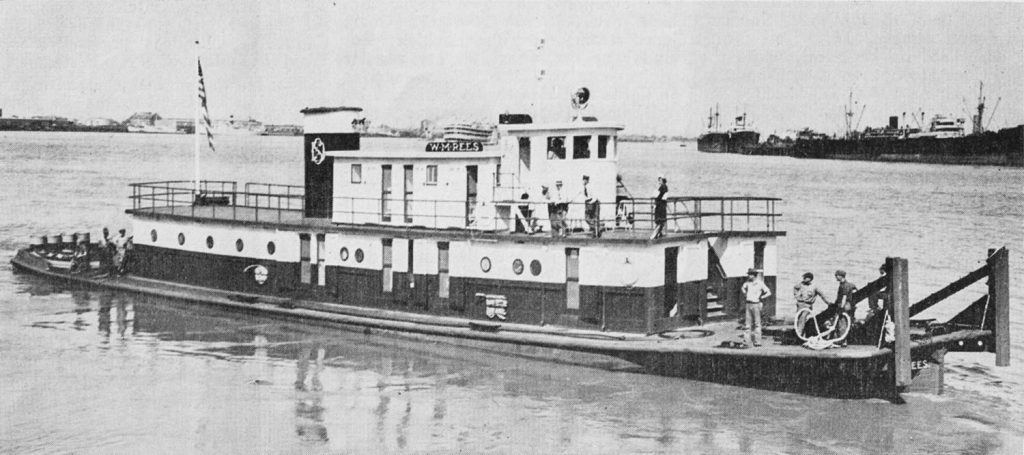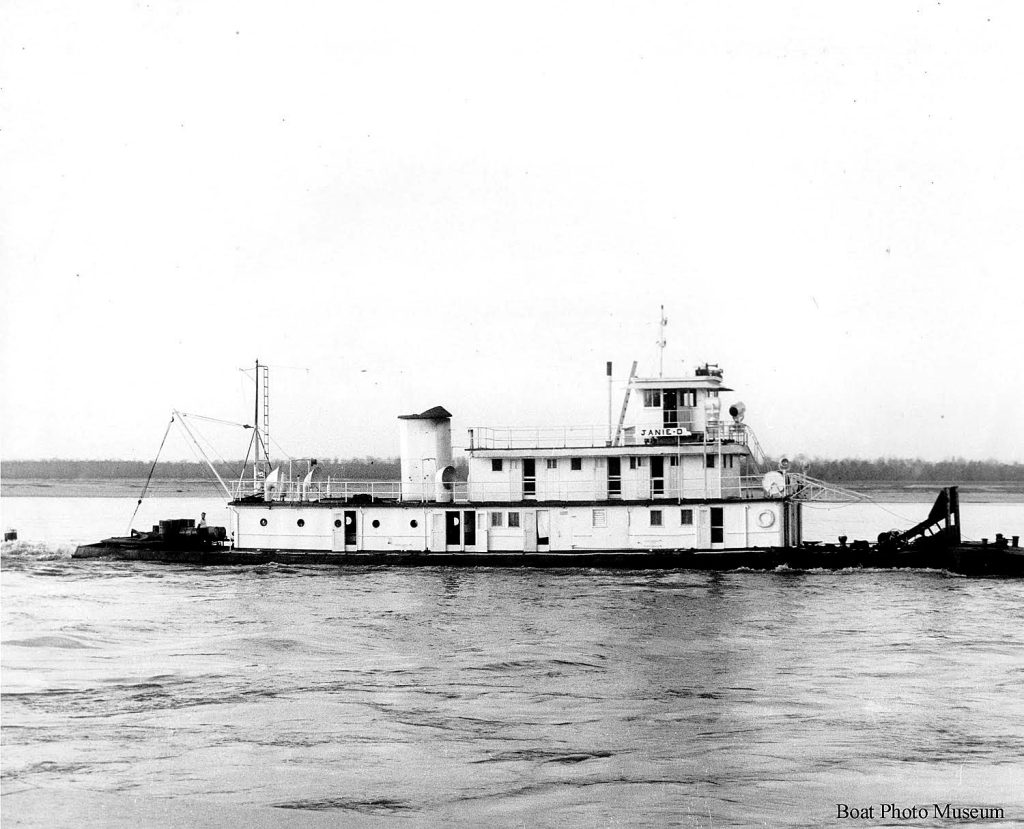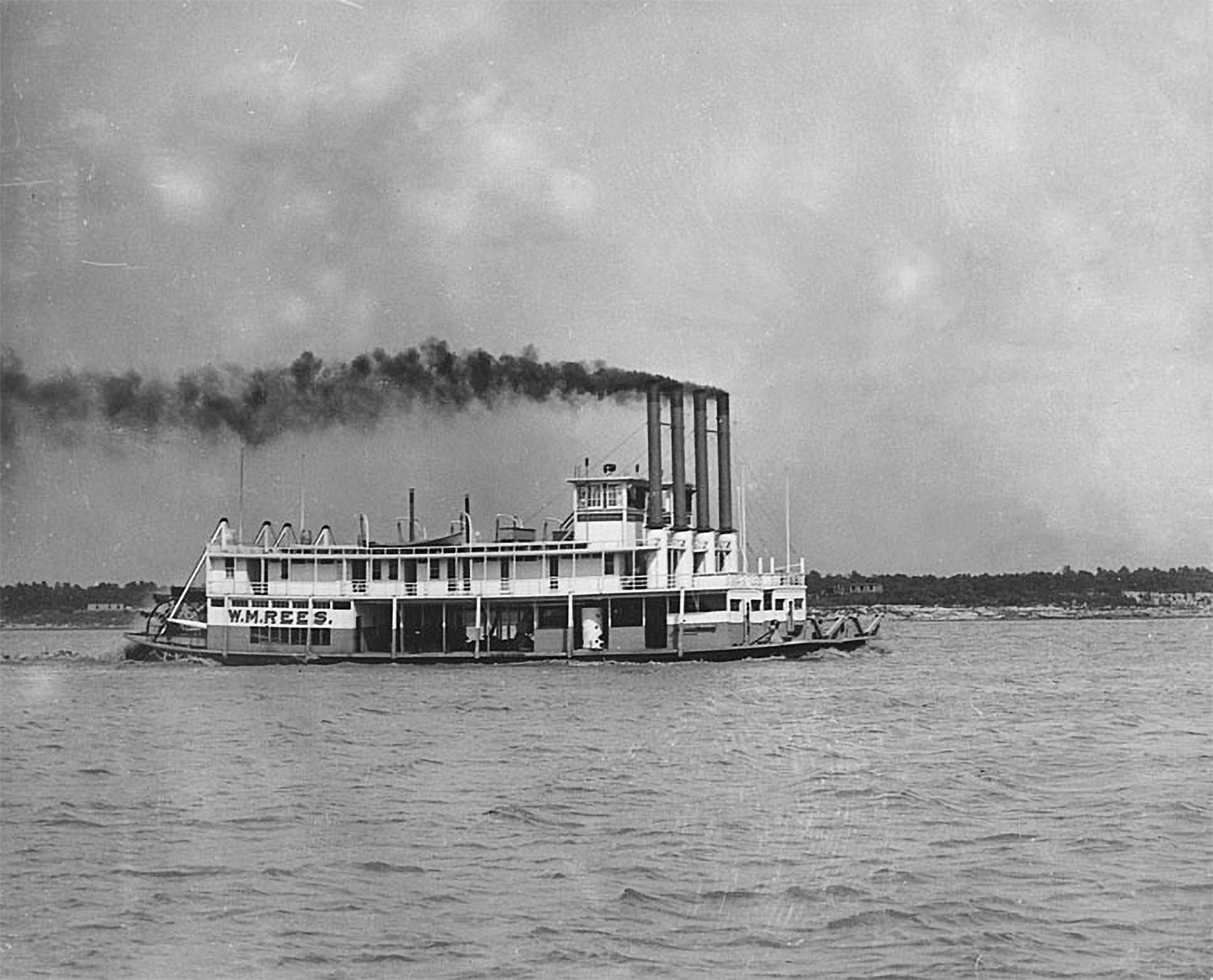As indicated by several histories of the local area, the construction of boats and river equipment in or near the town of Dubuque, Iowa, dates to the 1850s. A firm known as Rouse, Dean & Company, which was an iron foundry and machine shop, began business in 1852. This company, which later became the Iowa Iron Works, began building vessels about 1870. In 1902, the company built the famous steamer Sprague, the largest towboat ever built for river service. In 1904, the concern was reorganized, becoming the Dubuque Boat & Boiler Company. In 1912 and 1913, the Dubuque Boat & Boiler Company constructed twin sternwheel steam towboats for the U.S. Engineer Department. These boats, named Augustus J. Nolty and W.M Rees, respectively, would each have long careers. This column will focus on the Rees.
A photo of the Nolty and Rees lashed together and presumably on the delivery trip south from Dubuque has often appeared in print. Because the two boats were so similar, at first glance the image appears to be one vessel with four smokestacks. The boats as built had steel hulls 136 by 34 and 5 feet in depth. According to NavSource Naval History, they had high-pressure engines that were 18’s – 7-foot stroke. There was a full second cabin with a tall pilothouse situated forward on the roof and twin smokestacks ahead of that.
The W.M. Rees was initially assigned to the Memphis District and later also worked on the Illinois River. At some point, the Rees was rebuilt with the upper cabin shortened and the after part of it removed. The tall pilothouse was moved from the roof and set down ahead of the cabin in pool boat fashion. It continued in service to the Engineers until they retired it in 1940. It was then sold at a public sale to Eugene DeArmas of New Orleans.
Both Way’s Steam Towboat Directory and Capt. Way’s initial 1945 edition of the Inland River Record indicate that following the sale the Rees was rebuilt by the firm of DeArmas & Saunee Construction and Towing Company. The boat was converted to diesel from steam at this time and from sternwheel to propeller. The hull then measured 114.5 by 28.4 feet. The wooden cabins were replaced with new steel structures with a tug-type pilothouse located forward of the upper cabin. A single stack was located aft of the upper cabin. A pair of Cooper-Bessemer JS-7 engines were installed that totaled 1,200 hp. at 400 rpm.
A story in the August 2, 1941, issue of The Waterways Journal says the rebuilt boat, still with the name W.M. Rees, was chartered to a towing company and started up the Lower Mississippi. Some 6 miles below Memphis, the Rees sank. The story indicated that the exact cause of the sinking was unknown, but the boat rested in water 40 feet deep for more than a month. It was raised by the New Orleans Coal and Bisso Towboat Company and taken to Avondale Marine Ways at New Orleans, where the hull was patched. It was then delivered to Canulette Ship Building Company at Slidell, La., where the hull was completely rebuilt and the still-new engines were overhauled by representatives of the Cooper-Bessemer Corporation.

Following this extensive project, the Rees was declared “practically a new boat” and was placed on charter to the John I. Hay Company towing between Houston, Texas, and Chicago, Ill. While the WJ article stated that the name of the boat was planned to be changed to Cooper-Bessemer, “a tribute to her powerful engines and their survival of the ravages of the swift and muddy waters of the Mississippi River,” the name change never happened.
The boat was sold to the Hay Company, which renamed it Seneca. In 1946, it was sold to Cornelius Kroll & Company, Houston, which had it until it was sold in 1954 to Canal Barge Company. Within this time, the cabin of the boat was again changed, and it lost the tug-style pilothouse in favor of a more traditional towboat-type square structure placed atop the upper cabin.
As the Seneca, it would stop in the Cincinnati area southbound with empty tank barges and load autos on the top of the barges, according to Capt. Bill Judd of New Richmond, Ohio. He was involved in the loading while still in high school.
In 1955, it was acquired by C.V.C Towing Company, Greenville, Miss., which renamed it Janie D in 1958. Elk Towing Company, Point Pleasant, W.Va., headed up by Capt. Bob Bosworth, purchased the boat February 24, 1959.

The late Bernard “Moke” Hussell once related to this writer that he was a deckhand on the Janie D for Capt. Bosworth and was on it in 1960 when a calamity befell one of the main engines that rendered it unable to be repaired. The entire crew was then sent to Pittsburgh to board the Trojan, which Capt. Bosworth had just purchased from J&L Steel. The Janie D was laid up and never ran again, although it remained listed in the Inland River Record through the 1963 edition. The final disposition of this vessel, which had an interesting existence spanning nearly 50 years, is not known.
Caption for top photo: Rees and Nolty, maybe on delivery trip in 1913. (U.S. Engineers photo, David Smith collection)




